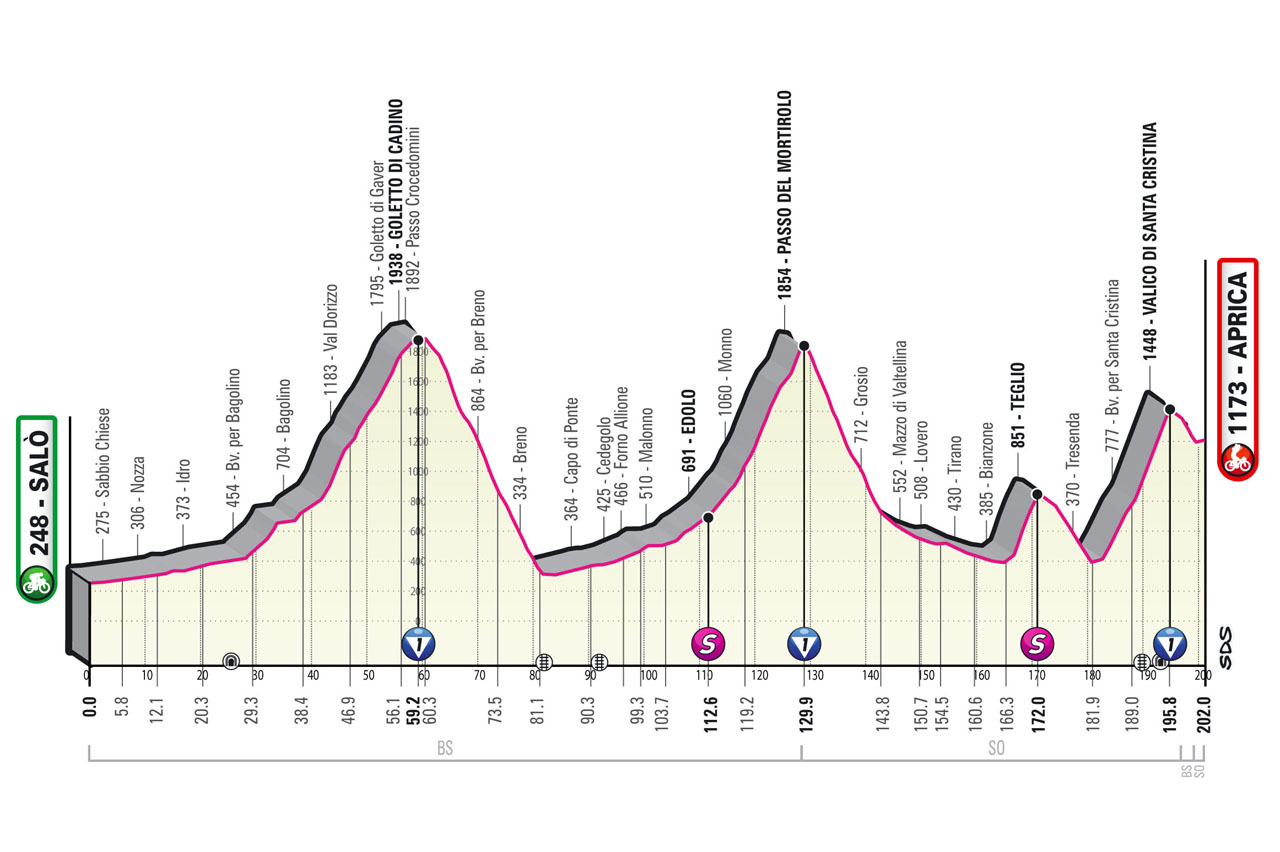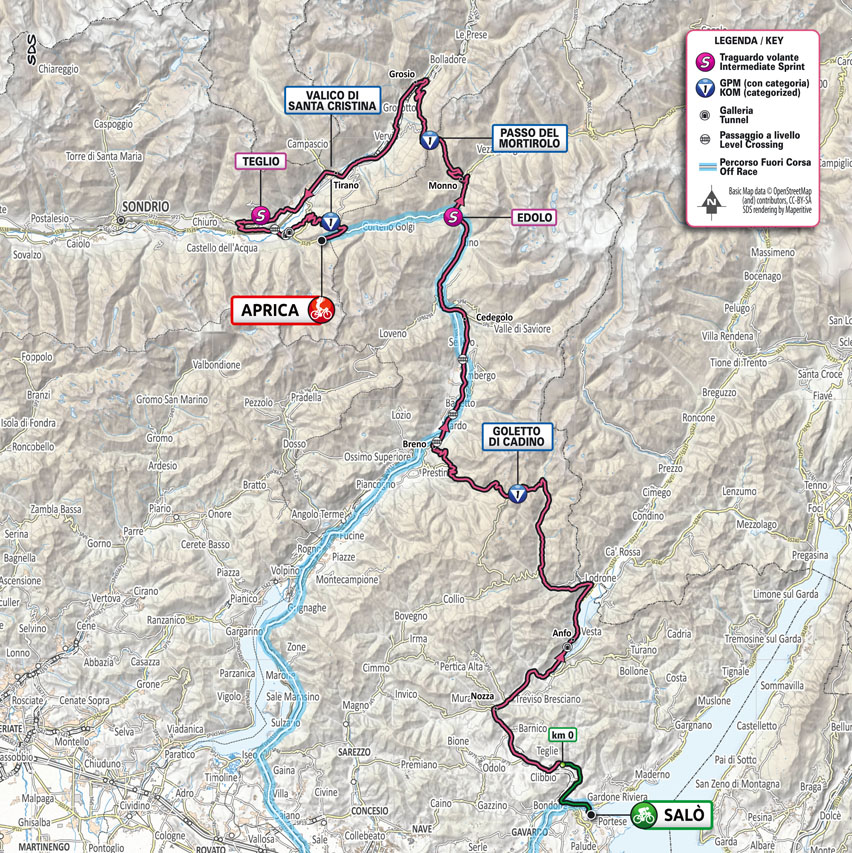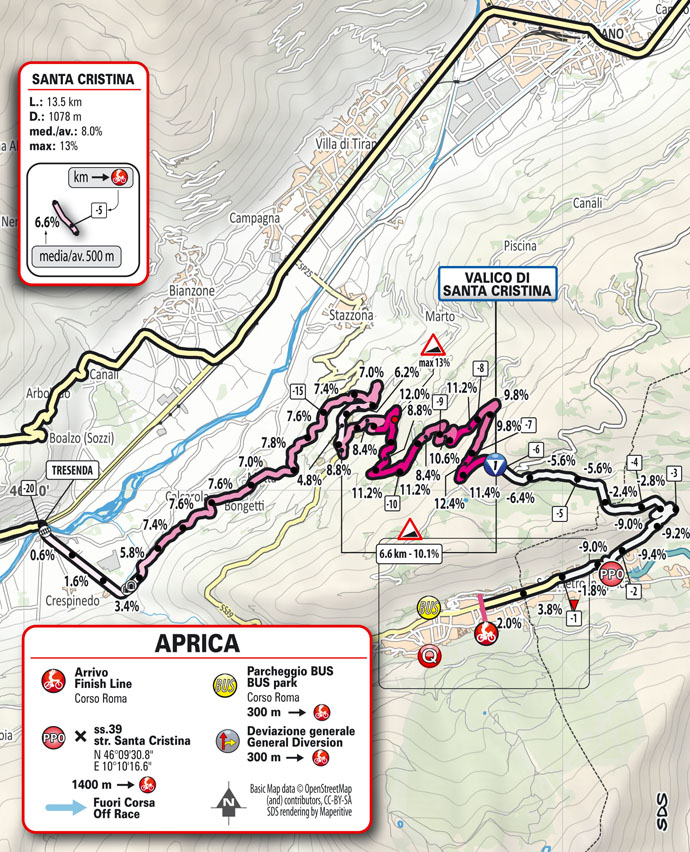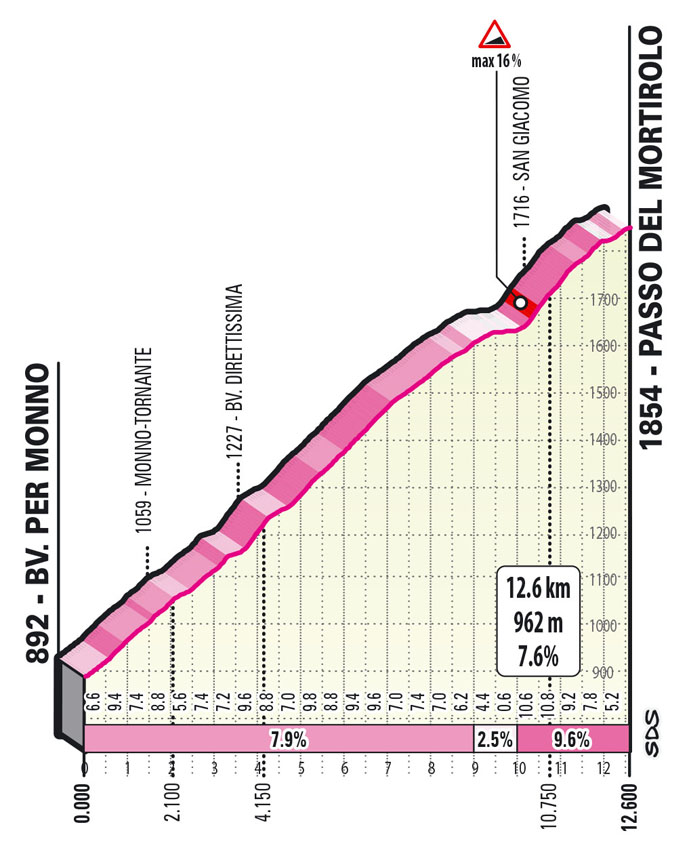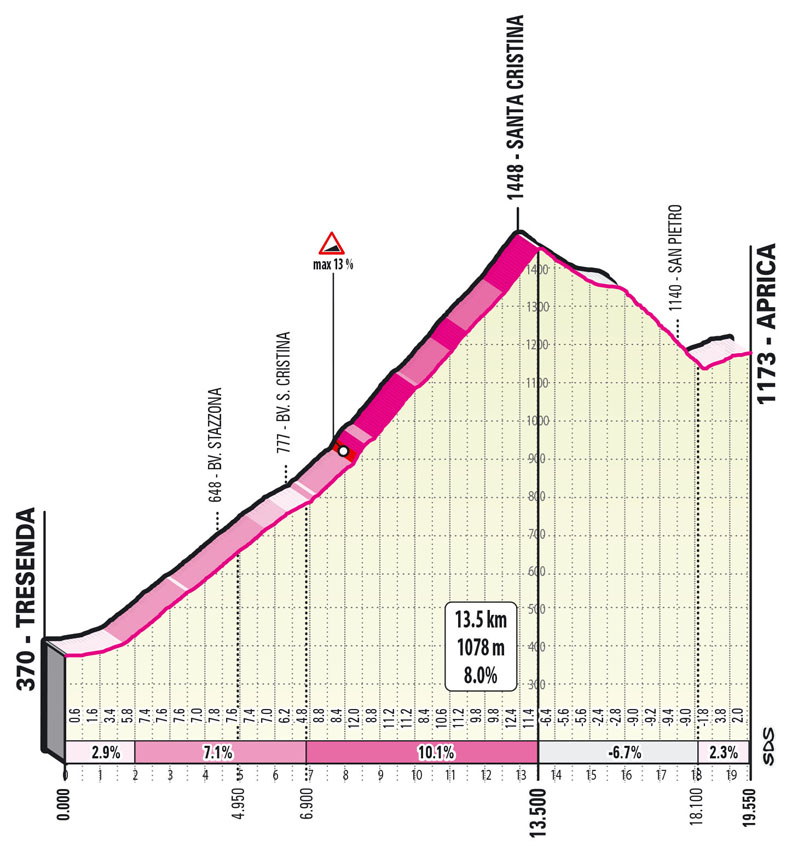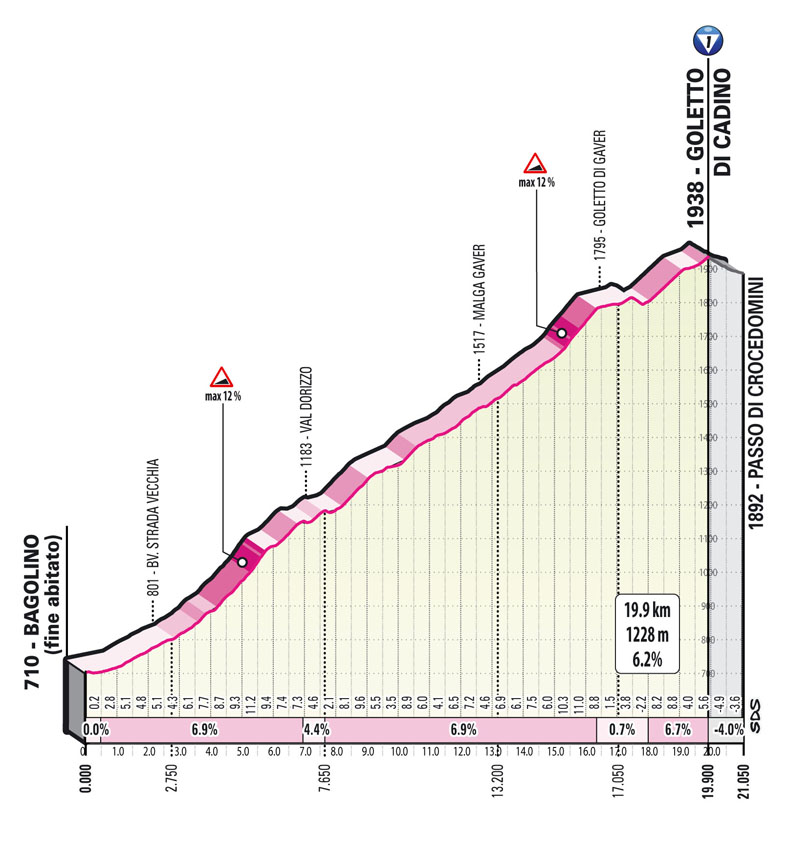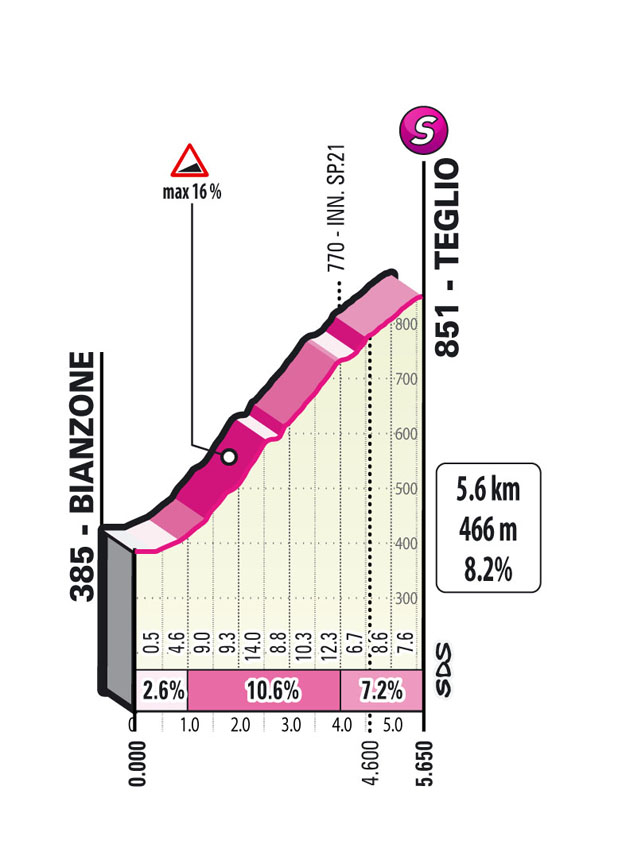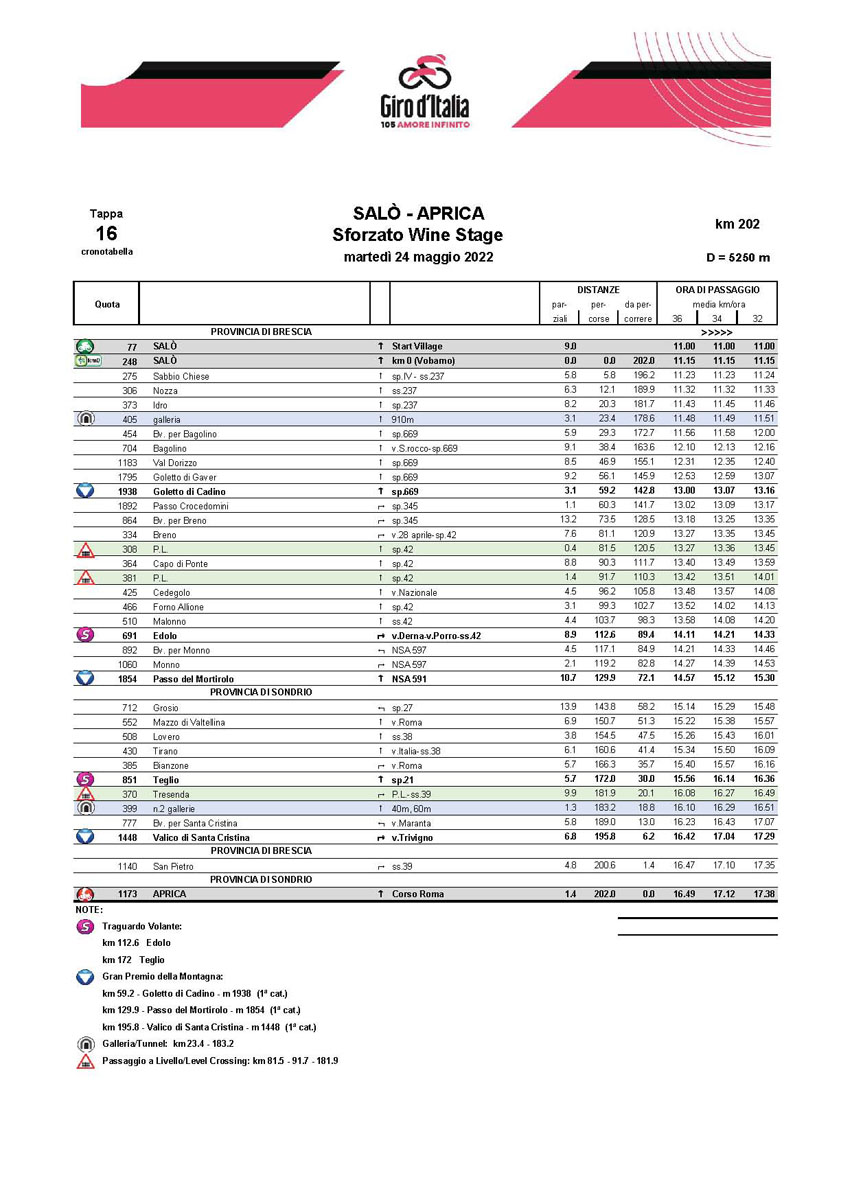profile
map
technical info
The route
A queen stage across the Alps, with over 5,000 m vertical altitude gain. The stage begins in Valsabbia, going up, and takes in a long climb (nearly 30 km) leading to the 2,000‑m Goletto di Cadino. The route drops into the Val Camonica (with a few level crossings along the way) and goes up again, reaching Edolo. The route then tackles the Passo del Mortirolo coming from Monno. Three km before the summit, the road narrows and the gradients rise. A technical descent follows, leading to Grosio on narrow road (quite steep at points). After a flat stretch, the route goes up again, heading for Teglio (on narrowed roadway, with gradients even exceeding 15% at points), and then descends rapidly towards Tresenda, before the closing ascent up the Valico di Santa Cristina. The road, wide and well-paved in the first part (with two short tunnels along the way), narrows as soon as it switches towards the summit. The route winds its way in hairpins through the woods, with sharp gradients, dropping sharply and rapidly into the finish.
Final kilometres
The descent from the Valico di Santa Cristina to the ‑1,500 m marker is highly technical, on narrow road and with sharp gradients. In the closing stretch, the route rises steadily at around 3% all the way to the finish (on tarmac).
start / finish
climb detail
final kilometres
itinerary timetable
tourist info
Host city:
Salò
Touristic Information
Salò is the first district of the Riviera of Lemons, it is exposed on an enchanting gulf in the foothills of S. Bartolomeo mount on the bank of Brescia territory of the High Garda. Framed by the sweet reliefs of the moraine amphiteatre, it has a mediterranean microclimate.
Already known in the Roman age, Salò has always played a crucial role in the history of Lake Garda and Italy.
The traces of a rich past are nowadays evident, infact walking in the old centre included between Piazza Carmine, the “Fossa” and the lakeside promenade, you can admire ancient buildings and elegant palaces of the 1600s as a testimonies of historic chapters of high cultural- artistic significance. Walking though alleys and little squares there are many shops, restaurants, bars and lodgings of high level. In the summer season there are a series of events that see classical and jazz music played live as protagonists, the floriculture festival, high-level sporting events and many other initiatives but, above all, the traditional Gasparo da Salò international violin festival, now in 64th edition seen among the longest-lasting and most famous summer festivals in Italy.
Gastronomy
In Salò you can taste the typical food and wine excellences of Upper Garda Park and of the nearby Valle Sabbia: these lands see the typical elements of the Mediterranean scrubs and the Alpine belt.
FISH
Lake fishes common in the Garda Lake waters are trout, tench, carp, burbot, lake whitefish, sardines, chub, pike, bleak and eel. The lake fish is not farmed but fished according to the old ways using traditional nets.
OIL
Garda oil’s excellent sensory profile and health benefits make it an oil of superior quality. It has a low free oleic acid percentage and is an ingredient in all the local dishes.
LEMONS
The citrus fruit grown on the western shore of Lake Garda are lemon, bergamot, citron and orange. Due to the favorable climate and through the use of special greenhouses, the production of lemons, such as the production of other citrus fruit, reached its maximum expansion around 1700 but still resist today thanks to the local culture.
In particular we remember our local company, Cedral Tassoni. Founded in 1793 as a Spezieria, Cedral Tassoni is an Italian company based in Salò, on the Brescia shore of Lake Garda, where the offices and production plant still reside today. In 2018 the company celebrated 225 years of activity, a rare and important milestone. The company has evolved to become a well-known and evocative brand, capable of breaking through the hearts of Italians and lasting beyond fashion. Today Tassoni, a world-class excellence, is recognized as one of the few companies that constantly and punctually controls the supply chain, guaranteeing the quality of the entire life cycle of the product. The peculiarities of the history of Cedral Tassoni are the fundamental elements that have contributed to creating successful products distributed all over the world: the tradition of distilling hydroalcoholic infusions made from cedar, respect for raw materials and a controlled supply chain that produces its own aromas, from the selection of the fruits to the preparation of the aromas, from the bottling to the finished product, with a foresight and a name that still today, after two centuries of history, delights the palates of true connoisseurs with a taste that never denies.
Beverages
The wines made around Lake Garda have been awarded denominazione d’origine controllata (DOC) status. The most famous local wines are white, rosè or red Garda Bresciano or Riviera del Garda Bresciano and Garda Bresciano Groppello. Wines made in the traditional way from groppello, barbera, marzemino and sangiovese grapes produce Garda Classico DOC. It has a bright ruby-red appearance and a delicate, characteristic nose typical of groppello. Its palate is fragrant and well-balanced, with a subtly bitterish finish. Garda Classico DOC can be drunk throughout a meal and is ideal with charcuterie and lean meat. The serving temperature is 15°-17°.
Other typical products of the western shore of Lake Garda are capers, traditionally conserved in olive oil or salt; the Garda truffle; cheese, from the Tremosine cheese to the Tombea cheese; honey, nutritious and of excellent quality, and grappa, produced in particular in the Tignale area.
Main sights
MU.SA
MU.SA museum is hosted into the rooms of the church and the Somasco college of Santa Giustina, a complex founded in 1587. The museum holds a collection of artworks, fine lutherie and antique machinery into its big and bright rooms organized in thematic path among the past and the future, the culture and the territory, the economy and the beauty in order to explain the history of Salò. www.museodisalo.it
DUOMO SANTA MARIA ANNUNZIATA
The cathedral of Santa Maria Annunziata (1453) represents the most important work in order of architectural valued of the town. It was planned by Filippo delle Vacche da Caravaggio and realized in late Gothic style, the facade is incomplete. Inside has Zenone Veronese and Paolo Veneziano paintings.
Antonio Vassillacchi, known as Aliense, did some frescoes inside the cathedral and the major altar is characterized of a majestic golden sacred image where there are ten wooden statues made by Pietro Bussolo.
PALAZZO DELLA MAGNIFICA PATRIA
Nowadays the building is the town hall. It is the symbol of the golden age of Serenissima. Built in 1524 it faced on the beautiful lake promenade. It’s Loggia has frescoes, commemorative headstones, many effigies and a bars relief of the Lion of San Marco as a witness of the passage of the city under the Venetian dominion in 1426.
Aprica
Touristic Information
A popular resort in summer and winter, Aprica links Valtellina with Valcamonica in the heart of italian Alps. The easily accessible, scenic resort has a bounty of activities for families. Aprica really shines in the summer as it transforms into an outdoor playground, full of cycling and hiking routes. Aprica will be familiar to many road riders as it often features in game-changing stages of the Giro d’Italia. Hit it up for some rewarding climbs, including the iconic Mortirolo and Santa Cristina. For off-road riders, there are many mountain bike routes to explore. Once the snowy season hits, skiers flocks to Aprica and its 50km-plus of ski pistes for all levels and tastes. Ranging from the Pistone on the Magnolta to the child-friendly ones next to the town, Aprica has it covered. As of the 2020/2021 season, Aprica lights up the hearts of night skiing fans with the super panoramic Baradello run, which is now the longest floodlit pist in Europe.
Gastronomy
Valtellina and Aprica are famous for their food excellence. Many of its products are certified as PDO and PGI certified. The local cheeses, wines, bresaola, apples and pizzoccheri are the outcome of this territory: from the valley floor to the icy peaks, it’s a neverending succession of terraced vineyards, cultivated fields, apple orchards, forests and alpine pastures. This variety and Valtellina’s long-standing agricultural and farming tradition give culinary delights. Valtellina’s traditional dishes are the perfect example of how its people have adapted to a difficult territory that offers an incomparable variety of resources. Valtellina is also known worldwide for its pizzoccheri. It’s a first course that encloses the authentic taste of Valtellina. Fresh buckwheat pasta, potatoes, cabbage, cheese, and Malga butter are the main ingredients. Sciatt is the fun side of Valtellina’s cuisine because of the shape, which gives the name to this dish. These cheese-filled buckwheat fritters are usually served on a bed of salad. These delicious nibbles have the shape of toads, hence the name sciatt (“toad” in Valtellina’s dialect). And of course, you can’t forget desserts! Aprica’s traditional dessert is called panvì, which consists of slices of rye bread toasted in butter and sprinkled with red wine and sugar.
Beverages
The bond between Valtellina and winemaking started in ancient times and has shaped the landscape uniquely. Over 2,500 kilometres of dry-stone walls run along Valtellina’s valley, creating 850 hectares of vineyards and Italy’s largest terraced area: 50 kilometres from Morbegno to Tirano. Nebbiolo delle Alpi, which locals call Chiavennasca, is the mother of Valtellina’s most elegant wines: Rosso di Valtellina DOC, Valtellina Superiore DOCG, and Sforzato di Valtellina DOCG. Rosso di Valtellina is ideal for first and second courses. Valtellina Superiore DOCG has 5 subzones – Maroggia, Sassella, Grumello, Inferno and Valgella – each of which gives a different personality to the wine. This wine is produced in the sunniest areas and aged for at least 12 months in oak barrels. It goes perfectly with Valtellina’s important dishes like pizzoccheri. Sforzato di Valtellina is the first Italian dry red raisin wine to be awarded the DOCG designation. It’s a full-bodied wine, made through a careful selection of every grape, dried until it loses 40% of its weight. Then, it’s left to age for at least 20 months to reach a minimum alcohol content of 14%. Every trip to Valtellina must include a visit to a winery and vineyard to discover what’s behind a good glass of local wine, tasted where it come to life.
Main sights
Ski
Aprica embrace a vast ski area with all kinds of ski slopes, from blue to black, to satisfy everyone, from beginners to the most proficient of skiers. The Campetti area is located in the heart of the town and is a veritable paradise for children. Then, we climb up to 2300m, to Valletta, the heart of Palabione. More proficient skiers can put themselves to the test on red and black slopes, like the Magnolta “Pistone”, while those looking to enjoy the panorama without too much sweat, will enjoy the Baradello Superpanoramica, over 6 km long. Slopes for all tastes, fun for grown-ups and children and, of course, chalets and solariums for relaxing after skiing.
Road bike
Aprica and the Valtellina valley are full of things to do for bike enthusiasts. Paths of different levels of difficulty, in terms of length and elevation difference, give you the chance to visit towns and historic hamlets, full of unexpected surprises. The Sentiero Valtellina runs alongside the Adda River and leads through orchards, with breathtaking views whatever the season. For fitter bikers, the local area is home to some of the “great ascents” made famous by the Giro d’Italia. Mortirolo, Gavia, Stelvio and S. Cristina as well as the Aprica pass.
Mountain bike
Aprica offers MTB enthusiasts a land rich in paths, dirt roads and military tracks that lead past characteristic lodges and alpine pastures, connecting stop-offs and refuges in the upper mountains, so that bike excursionists can enjoy a much needed rest. There are routes for families or more technical challenges for expert bikers, also ideal for enjoying a more comfortable e-bike experience
Hiking and walks
In Aprica over 200 kilometres of mountain paths and itineraries await you, enjoyable in full safety as you admire truly breathtaking views. There are simple paths, suitable for everyone, which lead through fascinating areas of naturalistic interest, like the Pian di Gembro Nature Reserve or the Valli di Sant’Antonio Nature Reserve, with the Brandet and Campovecchio Valleys.
The Alpine Nature Wildlife Sanctuary
The Aprica Alpine Nature Wildlife Sanctuary, created and directed by the biologist and naturalist Bernardo Pedroni, is a vast area of over 25 hectares, with an educational and naturalistic itinerary. Here you will have the chance to discover nature and observe some animal and plant species typical of the Orobie Valtellinesi Park.































